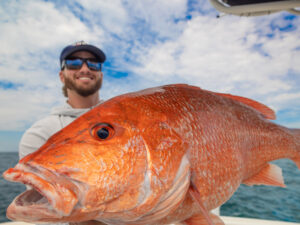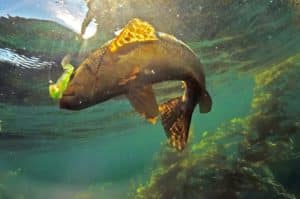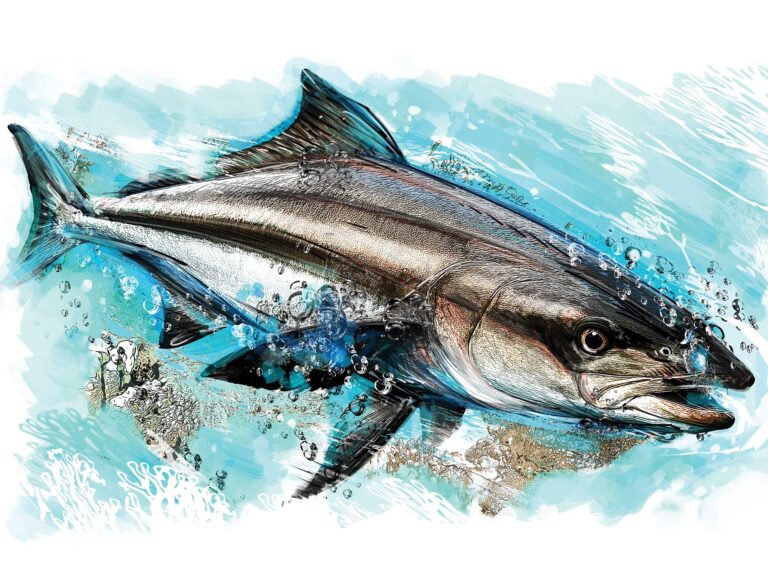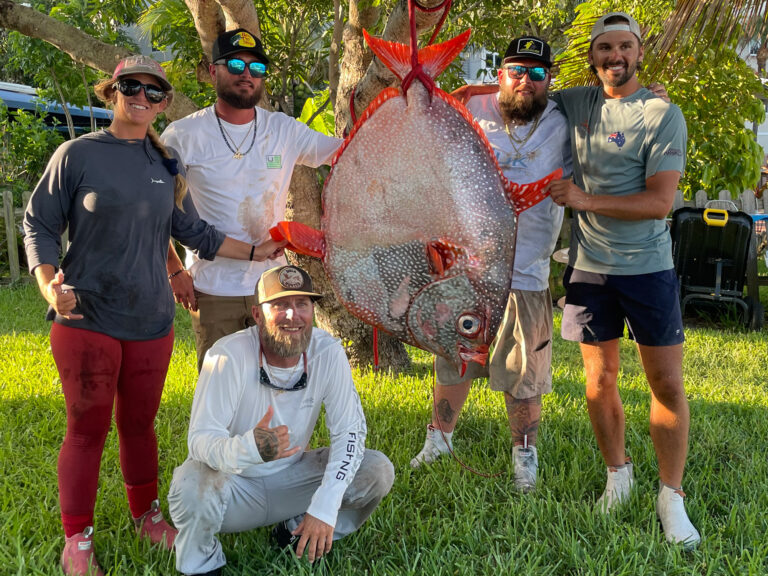
Something prowling the bottom of the Pacific sent shivers 200 feet up a downrigger cable, registered at the transom of the 27-foot Grady White that dipped at regular intervals in the gray early-morning chop. “OK, be ready now,” warned Matt Guiguet, our captain for the day
Years ago, we would have been drift-fishing over these halibut grounds, off northwestern Vancouver Island, waiting to cross paths with one of the big flatfish. But not these days. Guiguet — who with wife Kristy owns Rugged Point Lodge in Kyuquot (pronounced “Ki-YOU-cut”) Sound — had explained earlier that the lodge boats now routinely drop anchor in this moderately deep area. Then, using a transom-mounted downrigger, guides send down to the bottom a bag filled with chum.
Guiguet has found that it’s far more productive to bring the halibut to the boat than to go looking for them.
Two Halibut in the Boat
When, moments after those initial whacks, one of the halibut that the chum had called in found a bait with a circle hook in it and put a tight arc in a stout rod, I was a believer.

Angler Danny Munoz of Fairfax, Virginia, entered into a period of tough negotiations but finally persuaded a halibut of about 70 pounds to come to the boat. Guiguet quickly checked its length: Halibut exceeding 133 centimeters (about 52 inches) must be released unharmed. The fish proved barely under the limit — ideal size.
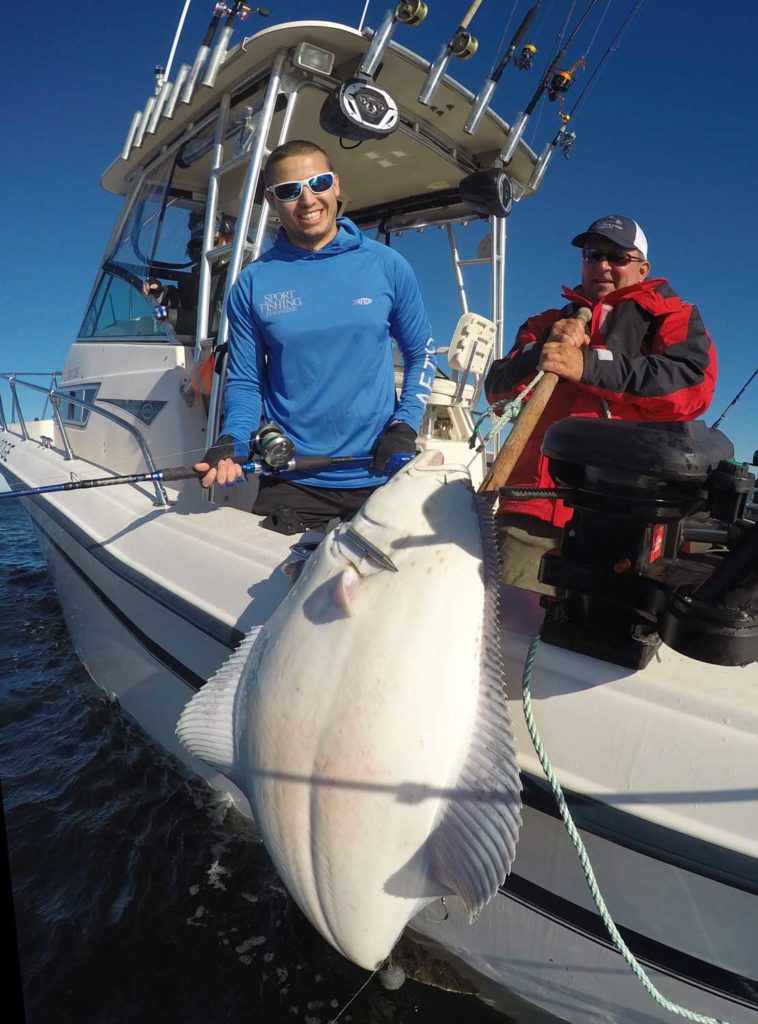
Before we could slide that big flounder into the fish box, the other rod began to buck in the gunwale holder, and we were in business again. Even as another angler worked on that fish, more halibut were trying to yank the chum bag from the cable far below.
There could be no doubt that chum calls ’em in very efficiently.

Meanwhile, with a solid breeze continuing to stiffen — as it would during the day — we agreed that we had plenty of halibut (likely more than 100 pounds or more of meat from the two fish, enough to fill a couple of coolers) and decided to fish calmer waters closer in.


Exploring Fishing Options as the Breeze Stiffens
Those first hours in three full days of fishing demonstrated some realities of fishing off remote Kyuquot Sound. First, its unpredictability is predictable.
The usual two question marks for fishermen — weather and fish — factor in big time up in these waters. The Pacific here often lays down for a day or two, or even several, but it can be windy for days or weeks. (Heavy fogs might roll in, but all the lodge’s boats are equipped with radar.) You have to roll the dice.

The other consideration is the fish themselves, notably salmon and albacore, both of which are migratory, often in large schools. Will they show up, and in what numbers and when, exactly? More rolls of the dice.
However, our first day out also proved that whatever the weather and the fish gods have in mind, there are always fish to be caught in these amazingly productive waters — there are always options. To really take advantage of that, smart anglers will be flexible and ready to capitalize on whatever they can reasonably target.
Recent seasons have seen some amazing salmon fishing. And by mid-August usually silvers are swarming, making for fast fishing.

Generally by mid-August, tuna are teeming off Vancouver Island, but the big question always is how far off? In “good” years, they’ll swarm within 15 to 30 miles of the coast, but they can be farther — more than 50 or 60 miles and often out of reach of sport boats.
There would be no tuna or big silver salmon schools this visit. Despite reports of albacore 50 or so miles out, a relentless north wind made that run unappealing. And the silver salmon runs, their timing never a sure thing, hadn’t shown.
So we adapted.

Trolling Anchovies on Downriggers for Salmon

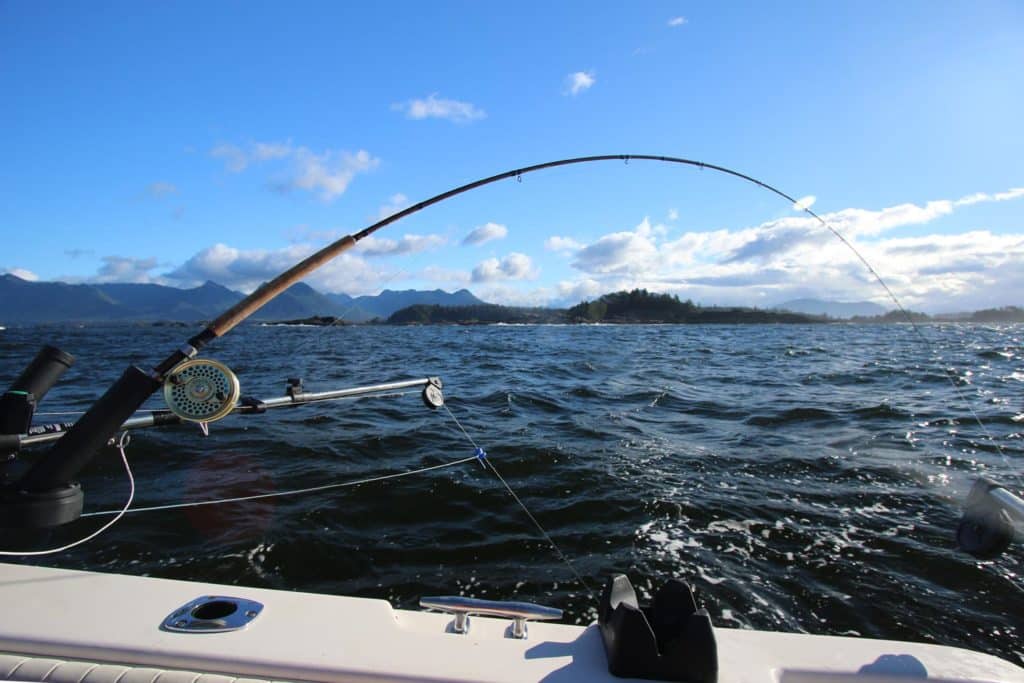
A run of bad luck saw three fish in a row missed or lost at the boat. One, a solid 30-plus-pounder, was nearly in the net when it darted suddenly around a downrigger cable — and that was all she wrote.
But after that, particularly on days two and three, we had their number and began regularly boating chinook of 12 to 20 pounds, known (up to 30 pounds) as “springs” in provincial parlance. Other lodge boats around us were having similar success.

Nonstop Action for Lingcod and Rockfish
Even if we didn’t see the kind of nonstop action that sometimes characterizes salmon fishing, anglers didn’t have to wait terribly long between bites.
We’d also come prepared for yet another option here. The rocky, irregular submarine terrain along the coast, much of it protected around and inside the barrier islands that extend from southwest to southeast of Kyuquot proper, offer pleasant fishing — even when it’s rough a bit farther out — for many species of rockfish, lingcod, possibly small halibut, and more.

It’s my experience over decades that light tackle is the key to enjoying this fishery. For that very reason, we’d brought a few light spinning outfits, filled with 15- to 20-pound braid. Such gear means that drifting and working jigs in 50 to 150 feet of water is not just a way to pass a bit of time, but also a whole lot of fun for a morning or afternoon. Sure, compared with fishing for tuna, salmon or halibut, the fish run smaller. But unlike in those fisheries, you never know what’s going to attack a jig.


While we caught greenling, rockfish and lingcod, we failed to hook a big halibut around the islands, but they do range from offshore banks into these nearshore waters, so a surprise flatfish is always possible.
But the bottom line (pun appropriate) is that when jigs are getting slammed and rods start bending with regularity, anglers quickly forget that this is a door-B alternative to whatever had been planned before the winds cranked up.
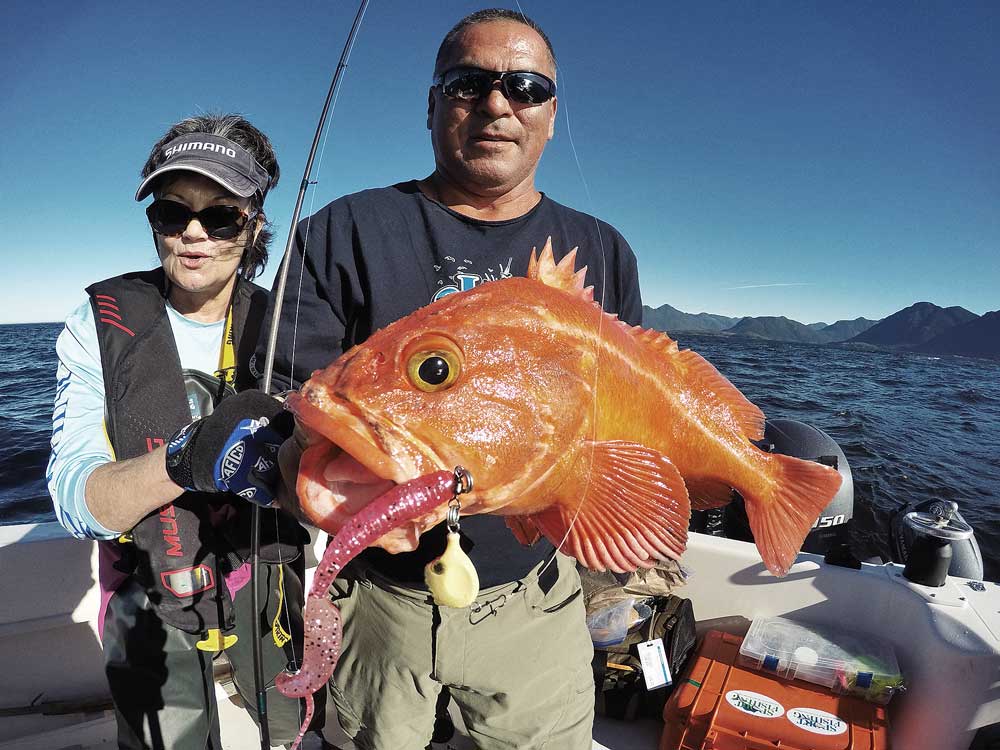

Such gear is also worth having on board for light-tackle enthusiasts when coho are swarming. While that didn’t materialize on this visit, I’ve fished off Vancouver Island in August when the coho were running as thick as expected, and at such times that light gear is again very handy.
Working smaller metal jigs in the upper 50 or so feet from a drifting boat is a real kick in the ass.

Otters, Eagles and Wolves
It would be an injustice to the experience of fishing off Kyuquot Sound if I failed to mention the coastal wildlife. Of particular note are the great colonies of sea otters and a rare pack of “sea wolves” living on an island.


If you’re particularly lucky — as are some anglers — while trolling for salmon, you might well spot loping along a beach one of the coastal timber wolves that have established permanent residence on Spring Island.

Then there are the bald eagles: omnipresent on the coasts of British Columbia and Alaska, and always awesome see. But in particular there is the bald eagle with which Guiguet has established a relationship going back years. Accordingly, on many days during the fishing season (but not daily), he’ll motor slowly past a certain area on one of the islands with a fresh slab cut from a salmon filet sitting conspicuously atop one of the big Yamahas. At least it’s — remarkably — conspicuous to the eagle sitting so far away that only its white head is visible, when it flies out of its tall fir, and in short order is swooping in to make a clean snatch-and-fly just a few feet from those standing, open-mouthed, in the boat’s cockpit.


A visit to a spot like Kyuquot seems a no-brainer for any angler’s bucket list. The beauty of this unspoiled, rugged coast and its wildlife combined with the extraordinary productivity of the north Pacific Ocean for sport fishermen make it well worth the trip to get here. Inconveniently, “Kyuquot” doesn’t actually mean “fishing place with many options” in the native tongue, but it certainly would fit.
PLANNING A TRIP TO KYUQUOT SOUND
Where
Tucked into the northern Pacific coast of Vancouver Island 200 miles northwest of Vancouver, Kyuquot Sound sits just the below the massive Brooks Peninsula Provincial Park. On Walters Island, a stone’s throw out from the tiny First Nations community of Kyuquot, is Rugged Point Lodge, accessible only by chartered or private floatplane or boat.
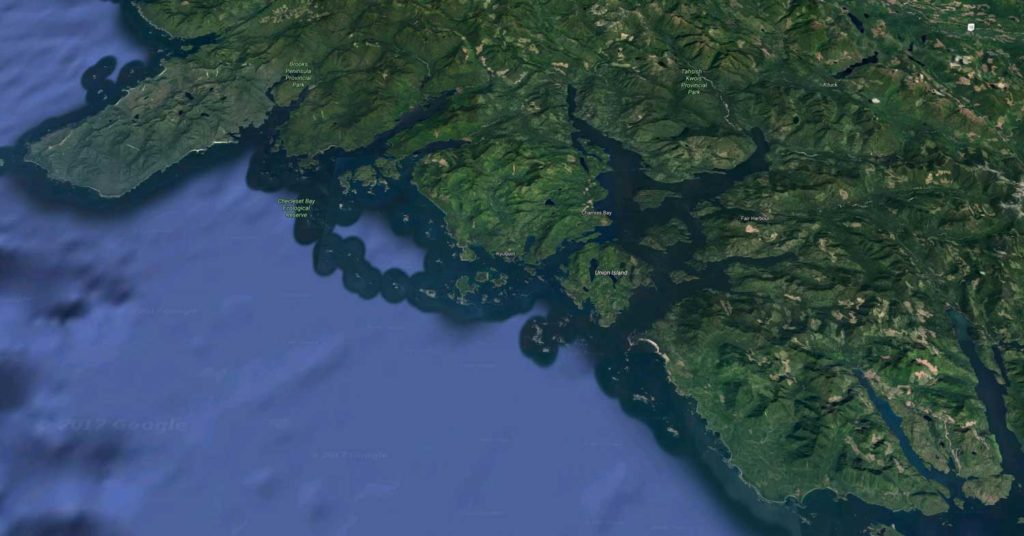
When
Rugged Point Lodge fishing begins in May and runs through early September.
How to Get There and Back Again
Most guests of the resort drive up Vancouver Island to Fair Harbour, about 20 miles to the northeast of Walters Island, where a lodge boat will be waiting for the scenic 45-minute run to the lodge.
We flew into Vancouver, where we rented a vehicle and overnighted at the Pacific Gateway Hotel, just a few minutes from the airport. The following morning, we drove the half-hour or so to the B.C. Ferries terminal at Tsawwassen, where the reservation for car and passengers we made online many weeks earlier (strongly recommended) assured us making the early-morning departure. We then drove the five or so hours from Nanaimo up-island, stopping for lunch en route to Fair Harbour.

Five days later, with our gear and coolers filled with frozen fish, we returned to the car and then (via ferry, per our reservation) to the airport to return the rental, and overnight right there at the Fairmont Vancouver Airport Hotel. The hotel’s proximity to the international-flight check-in counters — about a two-minute walk — made it a bit less onerous to join the queue for a 6 a.m. flight. Both of these hotels cater to visiting anglers, and at no additional charge will gladly put your whole frozen-fish coolers in their walk-in freezers overnight.

What to expect
Rebuilt by owners Matt and Kristy Guiguet in 2011, Rugged Point is a boutique fishing lodge with six guest rooms, each with its own head/shower, for up to 12 guests. We enjoyed fabulous meals in the large dining area adjacent to the main room with bar, wood stove and seating overlooking Walter’s Cove. Two or three anglers fish on one of three 23-foot Grady White Gulfstreams or up to four anglers on Matt’s 27-foot Grady.

What to Bring
Clothing to provide layers that you can add or shed as changing weather warrants. No need to worry about serious foul-weather suits or deck boots: Rugged Point has both on hand for guests. Your favorite potion for seasickness, should you be prone to that, is in order.
As noted in the text of this article, if you’ll want to fish really light spinning or levelwind gear, you should bring that, along with a selection of metal and lead-head jigs and plastic tails. Ditto your favorite fly gear if planning any river-fishing trips. We stopped during our drive up the island for some essentials — some special snacks and (since the resort stocks none), beer and wine. And of course, don’t forget to show up with a fishing license (which you can purchase online).

Bringing Your Fish Back
This is something most guests want to do — whether it’s salmon, albacore or halibut/bottomfish, just about every fish brought to the boat will make for superb eating. Accordingly, guests often bring coolers with them (each large enough to hold nearly 50 pounds of frozen fish) as we did. Brody Porter at SRP Processing will fillet, vacuum-pack and flash-freeze your catch daily, as he did for us. Back home, adhering to every reasonably portioned package of fish was a computer printout identifying species and date. SRP can also provide Styrofoam-lined boxes to take fish back on flights home.

For More Information or to Book a Trip
Contact Rugged Point Lodge (ruggedpointlodge.com). For general information about British Columbia and visiting anywhere in the province, visit hellobc.com.



